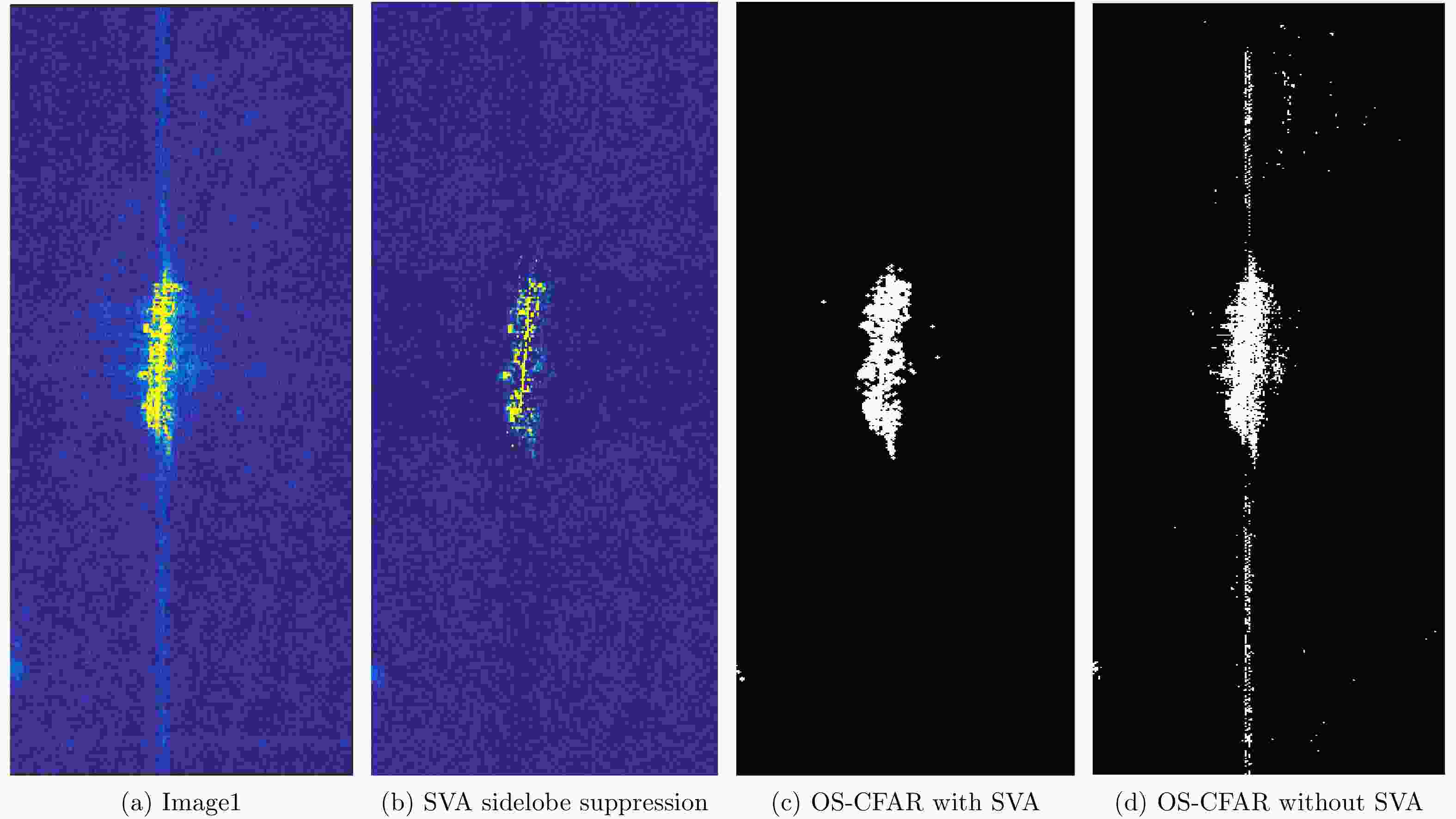Ship Detection Algorithm Based on Spatially Variant Apodization Sidelobe Suppression and Order Statistic-Constant False Alarm Rate
-
摘要: 由于合成孔径雷达(SAR)特殊的成像机制,导致了SAR图像上出现了旁瓣效应(SVA)。针对舰船目标检测过程中,旁瓣效应改变了强反射目标的形状导致的定位困难与定位错误问题,该文提出了一种基于空间变迹滤波与有序统计恒虚警率(OS-CFAR)的舰船检测算法。该算法将空间变迹滤波算法运用到复图像数据中,针对目标检测要求的实时性问题进行算法改进,通过全局CFAR只对潜在目标点进行旁瓣抑制而忽略对舰船检测无意义的大量背景点,在抑制旁瓣的同时减少了算法运算量。然后采用非线性的OS-CAFR算法对旁瓣抑制后的图像进行目标检测,并且采用形态学膨胀运算,弥补SVA算法可能造成的像素点幅值错误降低的问题。最后利用高分三号(GF-3)的实测数据进行验证,通过对比有无使用该文算法的结果的图像对比度与检查目标个数,体现了算法的有效性。Abstract: The special imaging mechanism of the Synthetic Aperture Radar (SAR) causes the sidelobe effect on SAR images. In target detection, the sidelobe effect changes the shapes of strong reflective targets, which results in the problems of localization difficulty and localization error. To solve this problem, this paper proposes a ship detection algorithm based on Spatially Variant Apodization (SVA) and Order Statistic-Constant False Alarm Rate (OS-CFAR). First, the global-CFAR algorithm is used to prescreen the potential target points, which reduces the computational burden of the following steps. Second, the SVA algorithm is modified to improve the speed of sidelobe suppression and applied to the raw complex image data. Then, the nonlinear method OS-CFAR is used to detect the targets on the processed image, and the morphological dilation processing is used to make up for the wrong suppressed points caused by the SVA algorithm. Finally, the GF-3 SAR images are used to test the algorithm and the comparison of the image contrast and detected numbers in the results with SVA and without SVA verifies the effectiveness of the proposed algorithm.
-
表 1 实验图像参数
Table 1. The parameters of test images
Test images Polarization Resolution(m) size Image1 HH 1 600$ \times $200 Image2 HH 1 700$ \times $350 Image3 HH 1 1300$ \times $600 表 2 实验图像结果
Table 2. The results of test images
Test images Contrast without SVA Contrast with SVA Detected number without SVA Detected number with SVA Image1 1.5944 1.9767 33 4 Image2 1.2619 1.7474 44 17 Image3 2.0533 2.3180 271 40 -
[1] FAWZY Z M, EL-SAMIE F E A, and FOUAD M. Processing of synthetic aperture radar data using frequency modulated signals[J]. Wireless Personal Communications, 2019, 107(2): 1061–1076. doi: 10.1007/s11277-019-06317-x [2] KERR D E. Propagation of Short Radio Waves[M]. New York: McGraw-Hill, 1951. [3] MOREIRA A, PRATS-IRAOLA P, YOUNIS M, et al. A tutorial on synthetic aperture radar[J]. IEEE Geoscience and Remote Sensing Magazine, 2013, 1(1): 6–43. doi: 10.1109/MGRS.2013.2248301 [4] HARRIS F J. On the use of windows for harmonic analysis with the discrete Fourier transform[J]. Proceedings of the IEEE, 1978, 66(1): 51–83. doi: 10.1109/PROC.1978.10837 [5] STANKWITZ H C, DALLAIRE R J, and FIENUP J R. Nonlinear apodization for sidelobe control in SAR imagery[J]. IEEE Transactions on Aerospace and Electronic Systems, 1995, 31(1): 267–279. doi: 10.1109/7.366309 [6] 王一丁, 纪慧波, 洪峻. 变量切趾技术在SAR/ISAR图像处理中的应用[J]. 电子与信息学报, 2003, 25(12): 1622–1627.WANG Yiding, JI Huibo, and HONG Jun. Application of apodization method in SAR/ISAR processing[J]. Journal of Electronics &Information Technology, 2003, 25(12): 1622–1627. [7] SMITH B H. Generalization of spatially variant apodization to noninteger nyquist sampling rates[J]. IEEE Transactions on Image Processing, 2000, 9(6): 1088–1093. doi: 10.1109/83.846250 [8] CASTILLO-RUBIO C, LLORENTE-ROMANO S, and BURGOS-GARCIA M. Robust SVA method for every sampling rate condition[J]. IEEE Transactions on Aerospace and Electronic Systems, 2007, 43(2): 571–580. doi: 10.1109/TAES.2007.4285354 [9] NI Chong, WANG Yanfei, XU Xianghui, et al. A SAR sidelobe suppression algorithm based on modified spatially variant apodization[J]. Science China Technological Sciences, 2010, 53(9): 2542–2551. doi: 10.1007/s11431-010-4035-z [10] LIU Min, LI Zhou, and LIU Lu. A novel sidelobe reduction algorithm based on two-dimensional sidelobe correction using D-SVA for squint SAR images[J]. Sensors, 2018, 18(3): 783. doi: 10.3390/s18030783 [11] El-DARYMLI K, MCGUIRE P, POWER D, et al. Target detection in synthetic aperture radar imagery: A state-of-the-art survey[J]. Journal of Applied Remote Sensing, 2013, 7(7): 071598. [12] ZHAO Bo, CHEN Li, ZHOU Xiaoyang, et al. Target detection from SAR images based on wavelet transform de-noise and improved CFAR[C]. Proceedings of SPIE 7495, MIPPR 2009: Automatic Target Recognition and Image Analysis, Yichang, China, 2009: 749539. [13] KAPLAN L M. Improved SAR target detection via extended fractal features[J]. IEEE Transactions on Aerospace and Electronic Systems, 2001, 37(2): 436–451. doi: 10.1109/7.937460 [14] XING X W, CHEN Z L, ZOU H X, et al. A fast algorithm based on two-stage CFAR for detecting ships in SAR images[C]. The 2009 2nd Asian-Pacific Conference on Synthetic Aperture Radar, Shanxi, China, 2010. [15] SMITH M E and VARSHNEY P K. VI-CFAR: A novel CFAR algorithm based on data variability[C]. 1997 IEEE National Radar Conference, Syracuse, USA, 1997. [16] GANDHI P P and KASSAM S A. Analysis of CFAR processors in nonhomogeneous background[J]. IEEE Transactions on Aerospace and Electronic Systems, 1988, 24(4): 427–445. doi: 10.1109/7.7185 -



 作者中心
作者中心 专家审稿
专家审稿 责编办公
责编办公 编辑办公
编辑办公

 下载:
下载:







